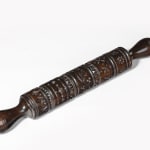Carved, Stained Sycamore Rolling Pin
WALES, CIRCA 1850
5.1 x 41.9 cm
2 x 16 ½ in
2 x 16 ½ in
6881
Provenance
Purchased Avon Antiques, Bradford on Avon, Wiltshire, March 1997
The decorative, carved details centred by a vine of leaves and berries between further bands of various foliate and geometric motifs. Used for impressing patterns onto butter or pastry. Sycamore...
The decorative, carved details centred by a vine of leaves and berries between further bands of various foliate and geometric motifs. Used for impressing patterns onto butter or pastry.
Sycamore was widely used for making rolling pins, as were other native woods such as oak and apple.
In Wales, such rolling pins were sometimes given as part of the Ystafell, or ‘Bidding’, a wedding tradition where, on the Friday before the wedding, household goods were brought to the couple’s home. Richard Bebb writes ‘The celebrations were major social events in the locality, and the gift-giving bound together a wide community, including craftsmen as well as farmers….The public display of the couple’s furniture – new or inherited – underlined the desirability of everyday objects being of good quality and bearing decorative features, and shows why pieces associated with weddings continued to hold attachments for descendants.’ (Richard Bebb, ‘Welsh Furniture’, Volume II (Saer Books, 2007), p. 215
Sycamore was widely used for making rolling pins, as were other native woods such as oak and apple.
In Wales, such rolling pins were sometimes given as part of the Ystafell, or ‘Bidding’, a wedding tradition where, on the Friday before the wedding, household goods were brought to the couple’s home. Richard Bebb writes ‘The celebrations were major social events in the locality, and the gift-giving bound together a wide community, including craftsmen as well as farmers….The public display of the couple’s furniture – new or inherited – underlined the desirability of everyday objects being of good quality and bearing decorative features, and shows why pieces associated with weddings continued to hold attachments for descendants.’ (Richard Bebb, ‘Welsh Furniture’, Volume II (Saer Books, 2007), p. 215




